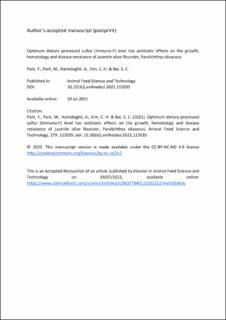Optimum dietary processed sulfur (Immuno-F) level has antibiotic effects on the growth, hematology and disease resistance of juvenile olive flounder, Paralichthys olivaceus
Peer reviewed, Journal article
Accepted version

Åpne
Permanent lenke
https://hdl.handle.net/11250/2982522Utgivelsesdato
2021Metadata
Vis full innførselSamlinger
Originalversjon
Park, Y., Park, M., Hamidoghli, A., Kim, C.-H. & Bai, S. C. (2021). Optimum dietary processed sulfur (Immuno-F) level has antibiotic effects on the growth, hematology and disease resistance of juvenile olive flounder, Paralichthys olivaceus. Animal Feed Science and Technology, 279: 115035. doi: 10.1016/j.anifeedsci.2021.115035Sammendrag
A great deal of research has been focused on feed additives that can boost the immune system of cultured fish since the food and drug administration (FDA) banned the use of antibiotics as feed supplementations in 2017. Sulfur is generally an essential element for the growth of animals, and sulfur-containing compounds are known to have anti-oxidant and anti-bactericidal effects. Although dietary sulfur has many potentials as a functional additive as well as an antibiotic replacer, it can also be toxic when supplemented at the high levels. Thus, it is necessary to determine the optimum amount in fish diet to exert positive effects on immune responses. Hence, an 8-week feeding trial was conducted to evaluate the optimum dietary processed sulfur (Immuno-F) level to replace antibiotic oxytetracycline (OTC) in juvenile olive flounder based on growth performance, hematology, and disease resistance. Each of 20 fish averaging 12.6 ± 0.17 g (mean ± SD) were randomly allocated into 8 groups of three tanks, and fed one of the eight isonitrogenous and isocaloric (crude protein 46.7 %, 160 kJ g−1) experimental diets formulated by supplementing Immuno-F at 0 ppm (Cont), 25 ppm (F25), 50 ppm (F50), 250 ppm (F250), 500 ppm (F500), 1000 ppm (F1000) and 2000 ppm (F2000), or oxytetracycline 4000 ppm (OTC4000). Weight gain and specific growth rate of fish fed F25, F500, and OTC4000 diets were significantly higher than those of fish fed F1000 and F2000 diets. In addition, superoxide dismutase, lysozyme and myeloperoxidase activities were not significantly different between sulfur and OTC supplemented groups. However, serum triglyceride levels of fish fed F1000 diet were significantly higher than those of fish fed F25, F50, F250, F500 and OTC4000 diets. In challenge test against Edwardsiella tarda at the 6th day, cumulative survival rates of fish fed F50 diet were slightly higher than those of fish fed F250-F2000 diets. Therefore, these results indicate that dietary processed sulfur at 50 ppm supplementation could replace antibiotic (OTC) in juvenile olive flounder.
